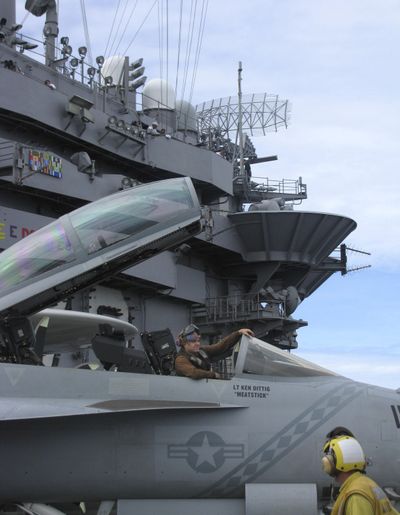China challenges U.S. naval mobility with carrier missile
Officials say weapon a game-changer

ABOARD THE USS GEORGE WASHINGTON – Nothing projects U.S. global air and sea power more vividly than supercarriers. Bristling with fighter jets that can reach deep into even landlocked trouble zones, America’s virtually invincible carrier fleet has long enforced its dominance of the high seas.
China may soon put an end to that.
U.S. naval planners are scrambling to deal with what analysts say is a game-changing weapon being developed by China – an unprecedented carrier-killing missile called the Dong Feng 21D that could be launched from land with enough accuracy to penetrate the defenses of even the most advanced moving aircraft carrier at a distance of more than 900 miles.
Analysts say final testing of the missile could come as soon as the end of this year, though questions remain about how fast China will be able to perfect its accuracy to the level needed to threaten a moving carrier at sea.
The weapon, a version of which was displayed last year in a Chinese military parade, could revolutionize China’s role in the Pacific balance of power, seriously weakening Washington’s ability to intervene in any potential conflict over Taiwan or North Korea. It could also deny U.S. ships safe access to international waters near China’s 11,200-mile-long coastline.
While a nuclear bomb could theoretically sink a carrier, assuming its user was willing to raise the stakes to atomic levels, the conventionally armed Dong Feng 21D’s uniqueness is in its ability to hit a powerfully defended moving target with pinpoint precision.
The Chinese Defense Ministry did not immediately respond to an Associated Press request for a comment.
Funded by annual double-digit increases in the defense budget for almost every year of the past two decades, the Chinese navy has become Asia’s largest and has expanded beyond its traditional mission of retaking Taiwan to push its sphere of influence deeper into the Pacific and protect vital maritime trade routes.
“The Navy has long had to fear carrier-killing capabilities,” said Patrick Cronin, senior director of the Asia-Pacific Security Program at the nonpartisan, Washington-based Center for a New American Security. “The emerging Chinese anti-ship missile capability, and in particular the DF 21D, represents the first post-Cold War capability that is both potentially capable of stopping our naval power projection and deliberately designed for that purpose.”
Setting the stage for a possible conflict, Beijing has grown increasingly vocal in its demands for the U.S. to stay away from the wide swaths of ocean – covering much of the Yellow, East and South China seas – where it claims exclusivity.
It strongly opposed plans to hold U.S.-South Korean war games in the Yellow Sea off the northeastern Chinese coast, saying the participation of the USS George Washington supercarrier, with its 1,092-foot flight deck and 6,250 personnel, would be a provocation because it put Beijing within striking range of U.S. F-18 warplanes.
The carrier instead took part in maneuvers held farther away in the Sea of Japan.
U.S. officials deny Chinese pressure kept it away and say they will not be told by Beijing where they can operate.
“We reserve the right to exercise in international waters anywhere in the world,” Rear Adm. Daniel Cloyd, who headed the U.S. side of the exercises, said aboard the carrier during the maneuvers, which ended last week.
But the new missile, if able to evade the defenses of a carrier and of the vessels sailing with it, could undermine that policy.
“China can reach out and hit the U.S. well before the U.S. can get close enough to the mainland to hit back,” said Toshi Yoshihara, an associate professor at the U.S. Naval War College. He said U.S. ships have only twice been that vulnerable – against Japan in World War II and against Soviet bombers in the Cold War.
Carrier-killing missiles “could have an enduring psychological effect on U.S. policymakers,” he said in an e-mail. “It underscores more broadly that the U.S. Navy no longer rules the waves as it has since the end of World War II. The stark reality is that sea control cannot be taken for granted anymore.”
Yoshihara said the weapon is causing considerable consternation in Washington, though with attention focused on land wars in Afghanistan and Iraq its implications haven’t been widely discussed in public.
Analysts note that while much has been made of China’s efforts to ready a carrier fleet of its own, it would likely take decades to catch U.S. carrier crews’ level of expertise, training and experience.
But Beijing does not need to match the U.S. carrier for carrier. The Dong Feng 21D, smarter and vastly cheaper, could successfully attack a U.S. carrier, or at least deter it from getting too close.
U.S. Defense Secretary Robert Gates warned of the threat in a speech last September at the Air Force Association Convention.
“When considering the military-modernization programs of countries like China, we should be concerned less with their potential ability to challenge the U.S. symmetrically – fighter to fighter or ship to ship – and more with their ability to disrupt our freedom of movement and narrow our strategic options,” he said.
Gates said China’s investments in cyber and anti-satellite warfare, anti-air and anti-ship weaponry, along with ballistic missiles, “could threaten America’s primary way to project power” through its forward air bases and carrier strike groups.
The Pentagon has been worried for years about China getting an anti-ship ballistic missile. The Pentagon considers such a missile an “anti-access” weapon, meaning that it could deny others access to certain areas.
Questions remain over when – and if – China will perfect the technology; hitting a moving carrier is no mean feat, requiring state-of-the-art guidance systems, and some experts believe it will take China a decade to field a reliable threat. Others, however, say final tests of the missile could come in the next year or two.